
Just Add Water And Stir Briskly The result is room-temperature, artificial snow for those who prefer to ski indoors
If it hadn't happened right in front of me, I would never have
believed it. I was in Kobe, Japan, in the manager's office of a
recently opened indoor snowboarding arena called Free-Ku. It was
late last summer. The office temperature was about 60[degrees]F.
The manager, Itaru Furukawa, opened what looked to be a sugar
packet and dumped the crystals into a small plastic container.
Then he poured in a cup of tap water and stirred.
The solution turned cloudy for an instant, and then the water
vanished. The crystals expanded like a yeast mixture in
overdrive. Within seconds the container was full of a billowy
white substance that looked strangely familiar.
"Snow," said the manager, beaming.
Well, almost. Free-Ku is the world's first facility to make use
of a product called PAS, which stands for polymer-based
artificial snow. It's a skiable material that can be produced at
room temperature. PAS is the invention of a Japanese company
called Snova, which keeps the product's ingredients secret.
"It is similar to the absorbing material in disposable diapers"
is all that Furukawa would divulge. He also mentioned that PAS
is safe enough to eat.
At Free-Ku's in-house shop, equipment rental costs about $50,
which includes a 90-minute snowboarding session. After changing,
I descended two flights of stairs, passed through a
sliding-glass door and emerged "outside"--or, rather, in an
entirely new type of inside. The Free-Ku snowboarding room,
roughly the size of a K Mart, consists of one groomed slope and
one carefully sculpted half-pipe, tipped at a gentle pitch and
coated with several inches of polymer snow. The temperature was
about 45[degrees]F. A concrete stairway that runs up the middle
of the room separates the two slopes, which are 164 feet long,
and serves as the ski lift. The walls and the ceiling are
painted gunmetal gray, music is piped in (Japanese rap), and
billboards hang everywhere. Ah, the great indoors.
PAS did make a fine impression of actual snow--with a few
limitations. I found it impossible to pack a snowball, and the
polymer snow "melted" in my bare hand in a peculiar way,
becoming a sort of syrupy lotion. Also, all over everyone's
clothing and hair, sparkling under the lights, were crystals
that seemed not to have absorbed any water--the PAS version of
unpopped kernels of popcorn. It was as if we'd all taken glitter
baths.
That explained the presence of a dozen high-pressure air hoses
posted near the exit. When the session ended, I lined up with
everyone else at the hoses, blew off all the crystals and
stepped back into summer.
Michael Finkel, who lives in Bozeman, Mont., prefers to
snowboard on the real stuff.
PAS is similar to the absorbing material in disposable diapers
and is said to be safe enough to eat.

